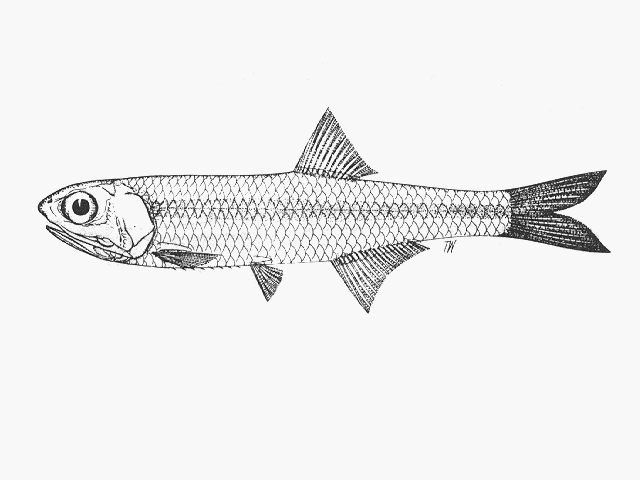| Engraulidae (Anchovies), subfamily: Engraulinae |
| 8 cm SL (male/unsexed) |
|
pelagic-neritic; brackish; marine; depth range 0 - 50 m, oceanodromous |
| Indian Ocean: Southwestern Indian Ocean, from northern Mozambique south to Port Elizabeth in South Africa (Ref. 189, 5430), including estuaries of Zwartkops River (Ref. 189, 5430), Kei River (Ref. 189) and Umtata River (Ref. 81587). |
|
Dorsal spines (total): 0-0; Dorsal soft rays (total): 15-17; Anal spines: 0-0; Anal soft rays: 20-23. Diagnosis: Body somewhat compressed, belly with 6-8 small needle-like pre-pelvic scutes, no post-pelvic scutes; maxilla tip pointed, reaching to or beyond hind border of pre-operculum, the latter concave, indented near maxilla tip; lower gillrakers 24-29; anal fin short, usually with 3 unbranched and 17-20 branched finrays, its origin below about middle of dorsal fin base (Ref. 189, 5430). Of similar species in its distribution area, Stolephorus indicus is round-bodied and has a shorter maxilla, not to hind border of pre-operculum; and Encrasicholina punctifer has the anal fin origin behind the dorsal fin base (Ref. 189).
Description: Body somewhat compressed; depth of body 5.0-5.5 times in total length; head length 23-26% of standard length (Ref. 1881, 5430, 122132). Snout pointed, strongly projecting, shorter than the eye; eye diameter 3 times in head length; teeth present in both jaws, minute; maxillary tapering behind, extending to the gill-opening (Ref. 1881, 5430). Lower gill rakers 24-29; upper gill rakers 17-22 (Ref. 5430, 122132). Dorsal fin with 3 unbranched and 12-14 branched rays, originating a little nearer root of caudal fin than end of snout; anal fin with 3 unbranched and 17-20 branched rays, originating below middle of dorsal fin; pectoral fin with 1 unbranched and 11-13 branched rays; pelvic fin with 1 unbranched and 6 branched rays; caudal fin deeply forked (Ref. 189, 1881, 5430). Caudal peduncle twice as long as deep (Ref. 1881). Scales: 38-42 scales in a longitudinal series, 9 in a transverse series (Ref. 1881, 5430). Pre-pelvic scutes 6-8, no post-pelvic scutes (Ref. 5430).
Colouration: A silvery lateral stripe is present along flanks (Ref. 1881, 5430). |
| A coastal, pelagic and schooling species; its presence in estuaries suggests that it can tolerate brackish water (Ref. 189). It is common along shore and in estuaries (Ref. 5430). It feeds on plankton, mainly copepods (Ref. 58304). It spawns in summer, usually at sea (Ref. 58304). |
|
Least Concern (LC); Date assessed: 28 February 2017 Ref. (130435)
|
| harmless |
Source and more info: www.fishbase.org. For personal, classroom, and other internal use only. Not for publication.
